According to the National Park Service, “hot springs are the most common hydrothermal features in Yellowstone.” And indeed, you can find these colorful pools at various locations throughout the park.
In fact, every single geyser basin in Yellowstone National Park—whether minor or major—has its own share of hot springs, which come in many shapes and colors.
From Mud Volcano and West Thumb to the Upper, Midway, and Norris Geyser Basins, the Yellowstone hot springs are without a doubt one of the greatest attractions in the park.
In this blog post, I’ve listed fifteen must-see hot springs in Yellowstone National Park, including some relatively less-known hot springs like Cistern Spring and Rainbow Pool, as well as ultra-popular destinations like Grand Prismatic Spring and Morning Glory Pool.
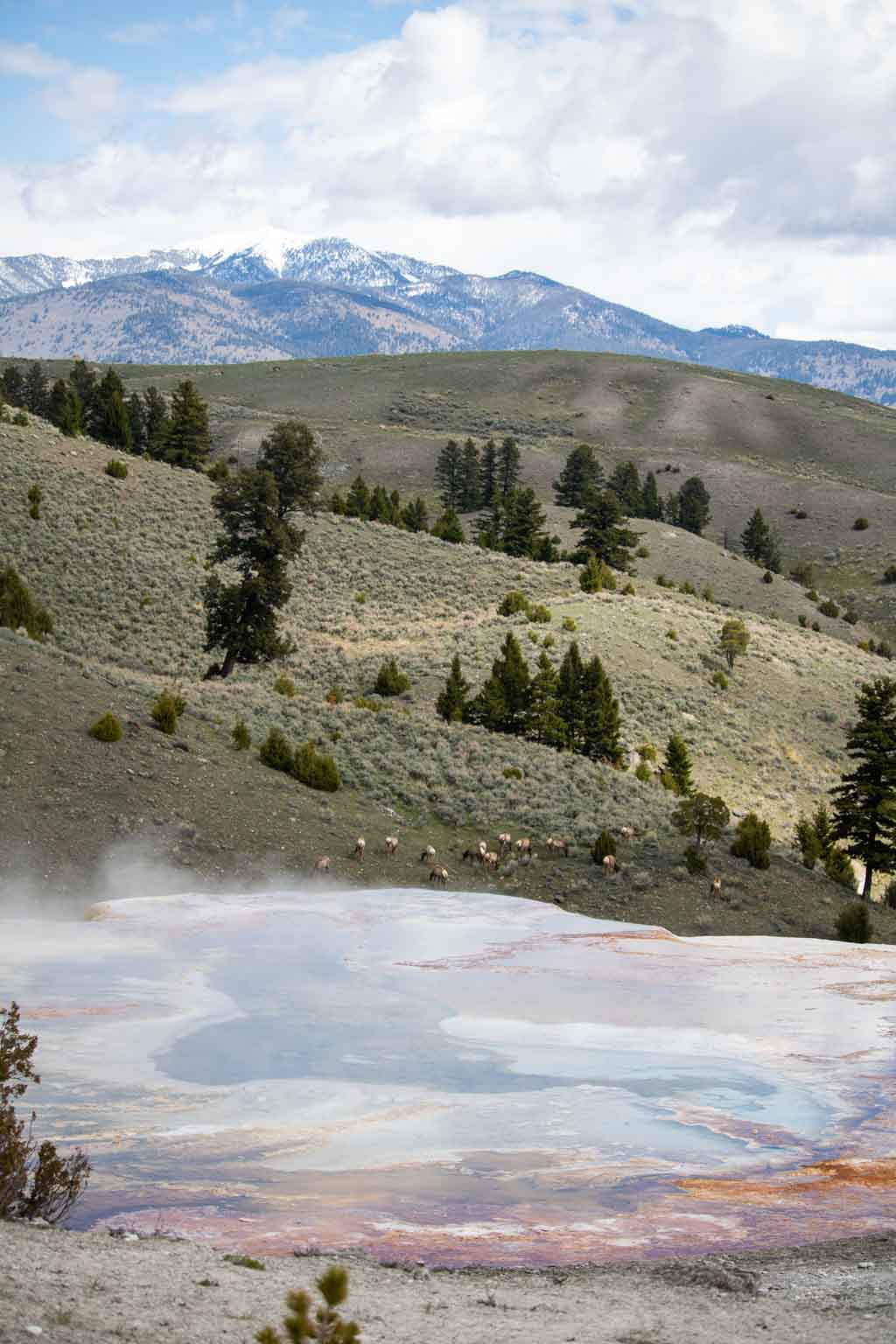
Contents
- Hot Springs of Yellowstone: What’s In a Name?
- What Is a Hot Spring?
- Why Are the Yellowstone Hot Springs So Colorful?
- Top 15 Hot Springs in Yellowstone National Park
- Top 10 Hot Springs in Yellowstone National Park
- Top 5 Hot Springs in Yellowstone National Park
- Map of Must-See Hot Springs in Yellowstone National Park
- More About Yellowstone National Park
Hot Springs of Yellowstone: What’s In a Name?
Due to the sheer abundance of hot springs in Yellowstone National Park, it seems like people eventually ran out of original names.
This is why you’ll find a number of hot springs with very similar names throughout the park, which can be quite confusing.
For example, there is an Emerald Spring but also an Emerald Pool. And even more baffling, you can see an Opal Pool, a Black Pool, and a Black Opal Pool, all of which are different Yellowstone hot springs in separate geyser basins.
The names of most hot springs reflect how they look, whether it’s their main color(s) or shape—or both in the case of Blue Star Spring.
The crystal-clear water and vibrant hues of several hot springs remind people of gems, resulting in names like Sapphire, Emerald, and Opal. Other springs are named after the minerals they contain or certain geological shapes, such as Silex Spring, Cistern Spring, and Crested Pool.
In an attempt to clarify things a bit more and distinguish between similarly named Yellowstone hot springs, I’ve made sure to include the general location of each hot spring below.
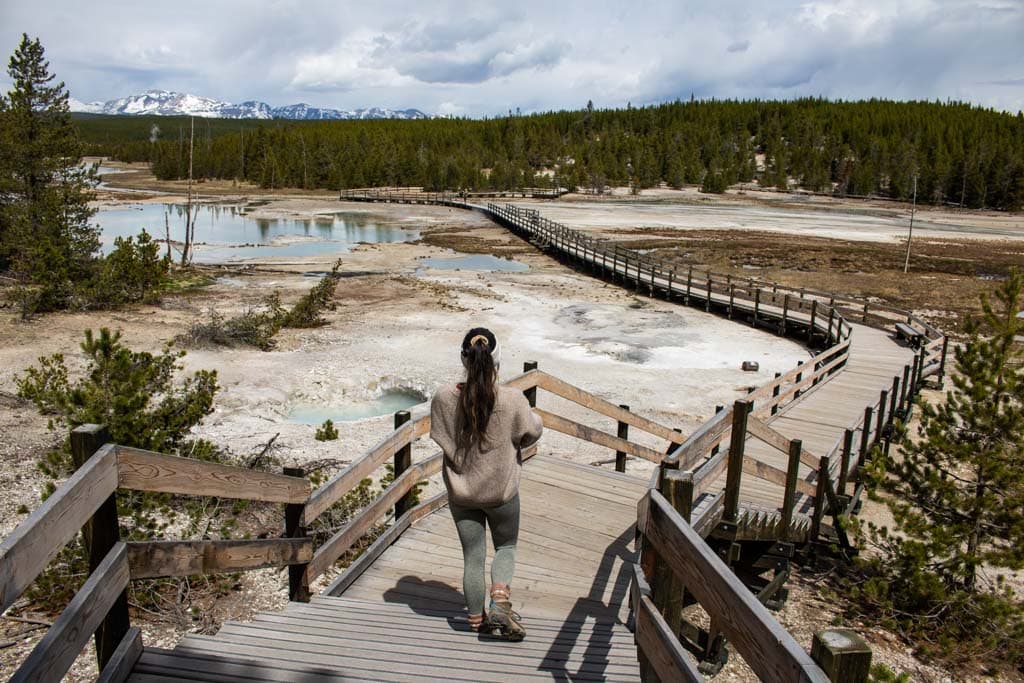
This blog post about must-see hot springs in Yellowstone National Park contains affiliate links. You can read more about our Terms of Use / Disclosure here.
What Is a Hot Spring?
As the name implies, a hot spring is essentially a natural pool with very warm water. Why is the water warm? you might ask. Well, let me explain!
The water of a Yellowstone hot spring starts off as rainwater (or snowmelt) that seeps through the bedrock beneath Yellowstone National Park. As the water trickles down, the park’s vast magmatic system “superheats” the water.
The heated water then rises back up to the surface via the expansive natural plumbing system that is unique to Yellowstone. Because convection currents circulate the water constantly, it never quite gets hot enough to cause a regular eruptions (which would make it a geyser).
As such, the water of a hot spring permanently stays hot—sometimes very close to boiling—yet not hot enough to cause it to “boil over”, so to speak, as geysers do.
Fun fact: Technically speaking, a geyser is also a hot spring, albeit it one that regularly or occasionally shoots a column of water into the air once enough pressure has built up below the surface. In this blog post, I’ll focus only on the “actual” hot springs in Yellowstone that do not—or very rarely—erupt.
To summarize, a hot spring is a pool of geothermally heated water that rises up from below the Earth’s surface, but does not erupt.
In addition to hot springs and geysers, Yellowstone National Park also has three other types of hydrothermal features. Those are travertine terraces, mudpots, and fumaroles.
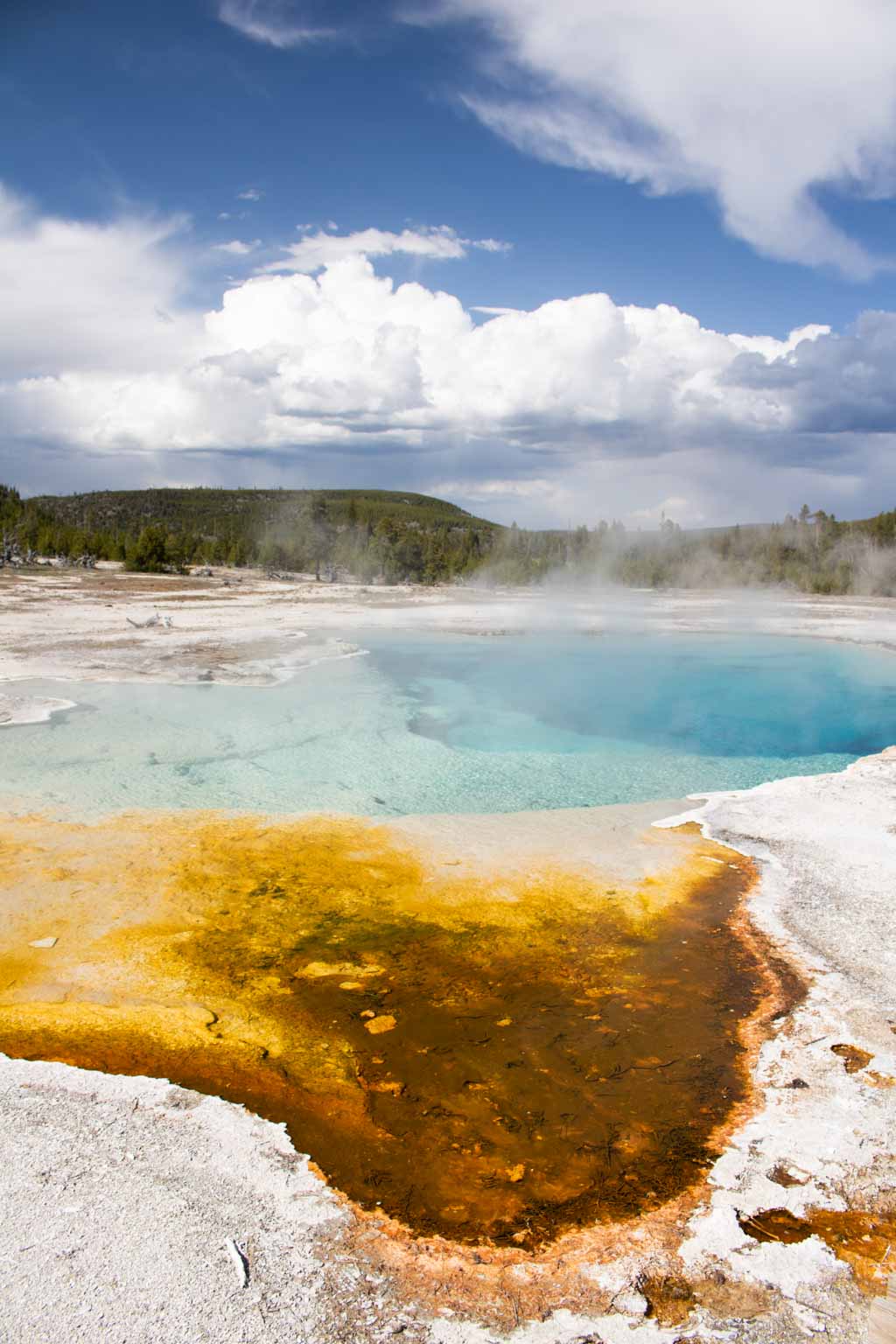
Why Are the Yellowstone Hot Springs So Colorful?
What makes the hot springs of Yellowstone such popular attractions are their often-vibrant colors. Many of those colors come from so-called thermophiles—from the Latin words “thermo” for heat and “phile” for lover.
Those “heat lovers” are an incredible variety of micro-organisms, such as cyanobacteria and algae, that are adapted to life in extreme conditions. In this case, they thrive in exceptionally high temperatures.
It’s those thermophiles that provide the vibrant colors Yellowstone’s hot springs are known for. The colors you see are actually the micro-organisms themselves—trillions of them, grouped so close together they look like colored rocks.
Each temperature range in a hot spring has its own set of micro-organisms, responsible for a specific color. This is why the hot springs in Yellowstone National Park have those remarkable bands of color that radiate out from the center.
- Colorless and yellow thermophiles live in the hottest water.
- Orange, brown, and green thermophiles live in cooler water.
You can learn much more about thermophiles on the Yellowstone National Park website.
Additionally, many hot springs in Yellowstone are also amazingly blue. This is because sunlight penetrates deep into these pools of crystal-clear water.
Sunlight is made up of the rainbow of visible colors, of which blue is scattered the most in this water. And therefore, blue is the color our eyes see in many of the Yellowstone hot springs..
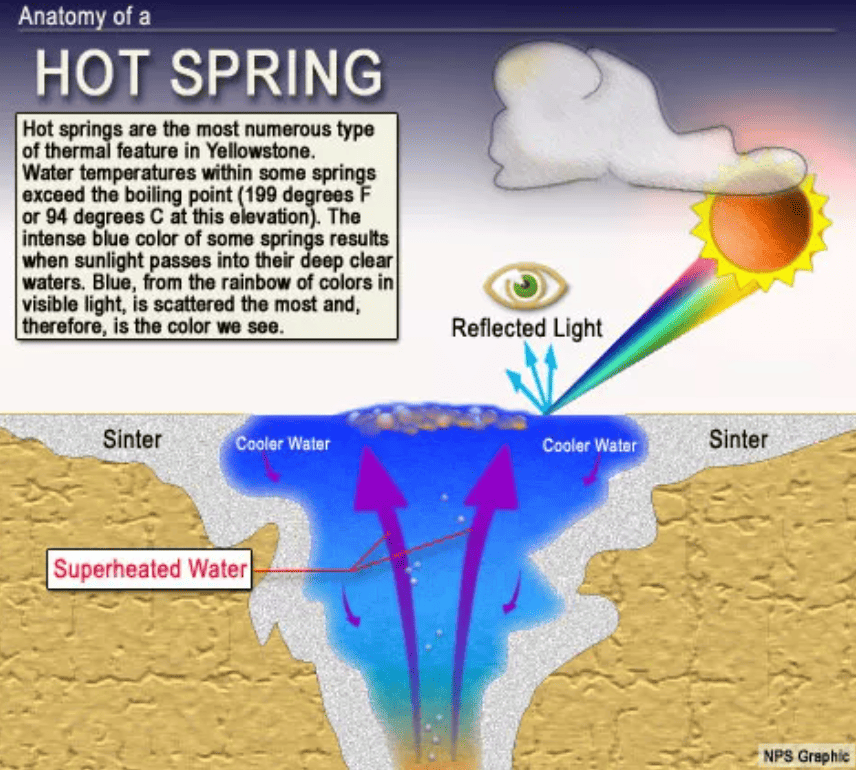
Top 15 Hot Springs in Yellowstone National Park
15. Rainbow Pool
- Location: Upper Geyser Basin (Black Sand Basin)
- Temperature: 149.3°F (65.2°C)
- Acidity (pH): 3.5
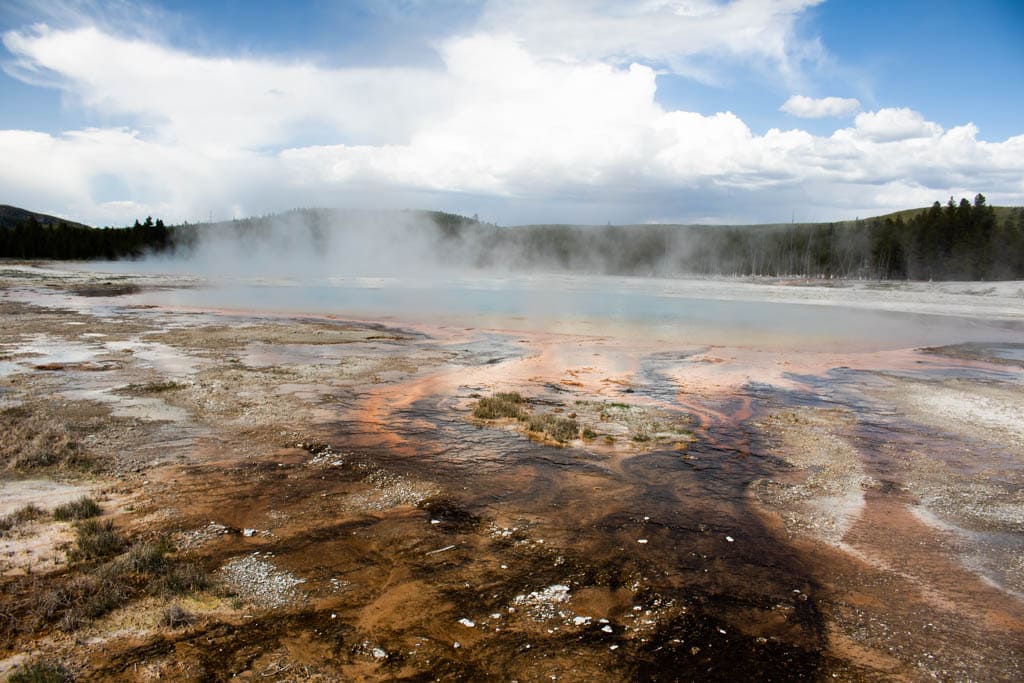
Located in Black Sand Basin, which is near the ultra-popular Upper Geyser Basin, Rainbow Pool is a pretty large hot spring in Yellowstone. Its diameter is 100 feet.
A relatively hot and acidic natural pool, its water is clear and blue, surrounded by yellow and orange thermophiles. It’s an impressive hot spring, both in terms of size and color.
The water of Rainbow Pool overflows its sinter rim and flows toward and eventually into the Firehole River.
14. Cistern Spring
- Location: Norris Geyser Basin (Back Basin)
- Temperature: 185°F (85°C)
- Acidity (pH): about 5
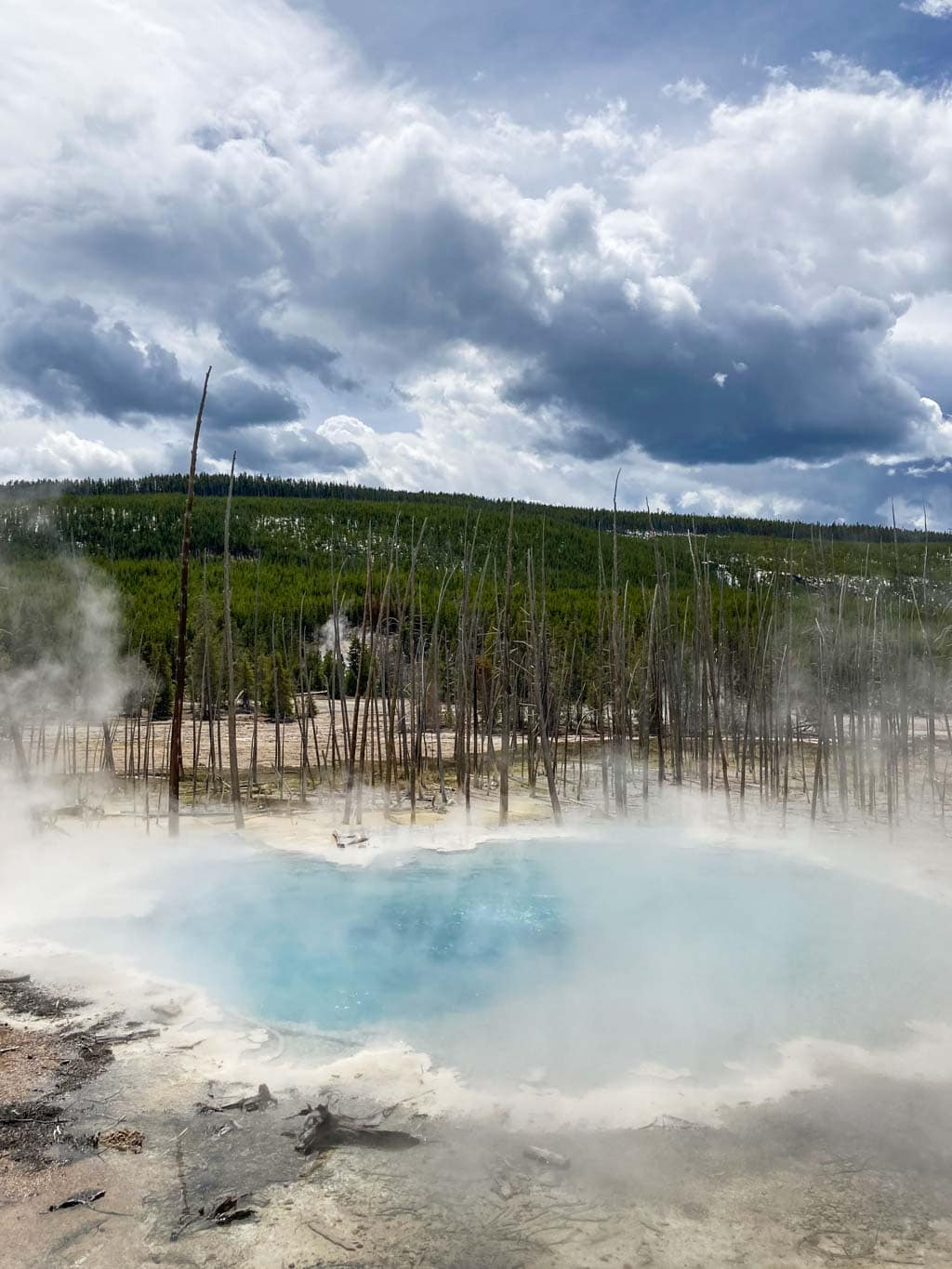
Cistern Spring sits in the extremely volatile Norris Geyser Basin, one of Yellowstone’s most acidic and hottest geyser basins. Situated at the intersection of three major faults, it’s very prone to earthquakes, which can drastically alter the behavior of its geysers and hot springs.
This particular hot spring is remarkable because it’s linked underground to the famous Steamboat Geyser.
The underground connection between both hydrothermal features became clear in 1983 when Cistern Spring emptied after every eruption of nearby Steamboat.
When it is filled with water, Cistern Spring is a gorgeous blue-green pool that continuously overflows. Its silica-rich water that spills over continues to affect the surrounding lodgepole pine trees, many of which have died.
“Norris has the greatest water chemistry diversity among Yellowstone’s hydrothermal areas. The water chemistry [including temperature and pH] changes as the water levels of underground hot water reservoirs fluctuates,” the National Park Service says.
13. Emerald Pool
- Location: Upper Geyser Basin (Black Sand Basin)
- Temperature: 136.3°F (58°C)
- Acidity (pH): 9
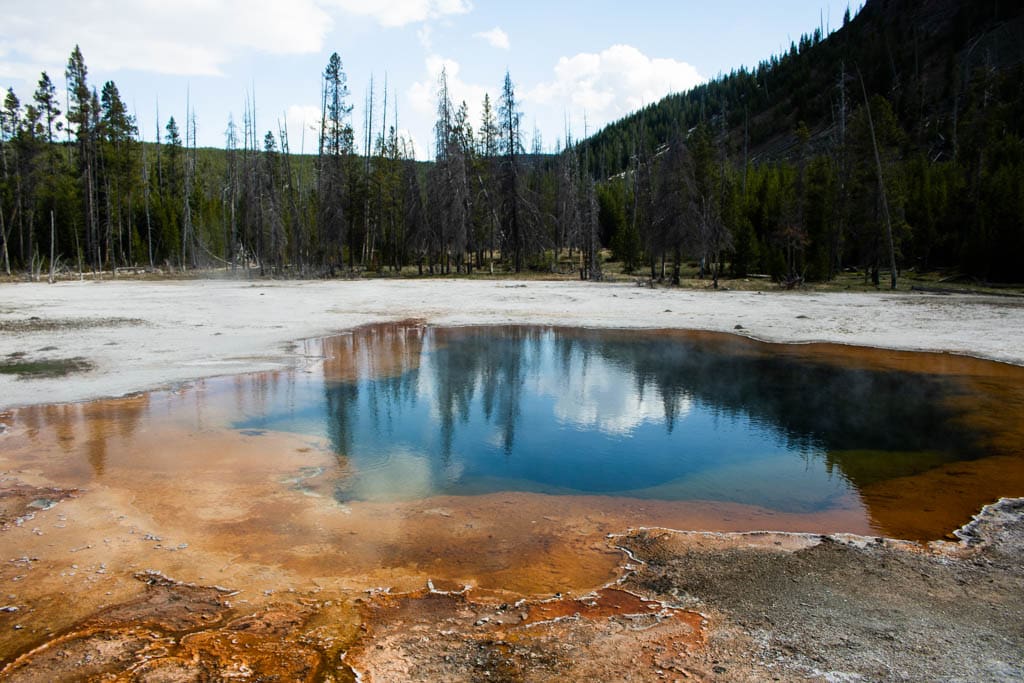
Beautiful Emerald Pool was once a blue hot spring with yellow thermophiles, which gave it a greenish hue—hence its name.
However, like many other hot springs in Black Sand Basin, its water temperature has dropped. This resulted in a shift in thermophiles, too, which are now bright orange.
Those orange thermophiles encircle the pool, while they’re also clearly visible in the run-off channel.
12. Blue Star Spring
- Location: Upper Geyser Basin
- Temperature: 190.7°F (88.2°C)
- Acidity (pH): 8.9
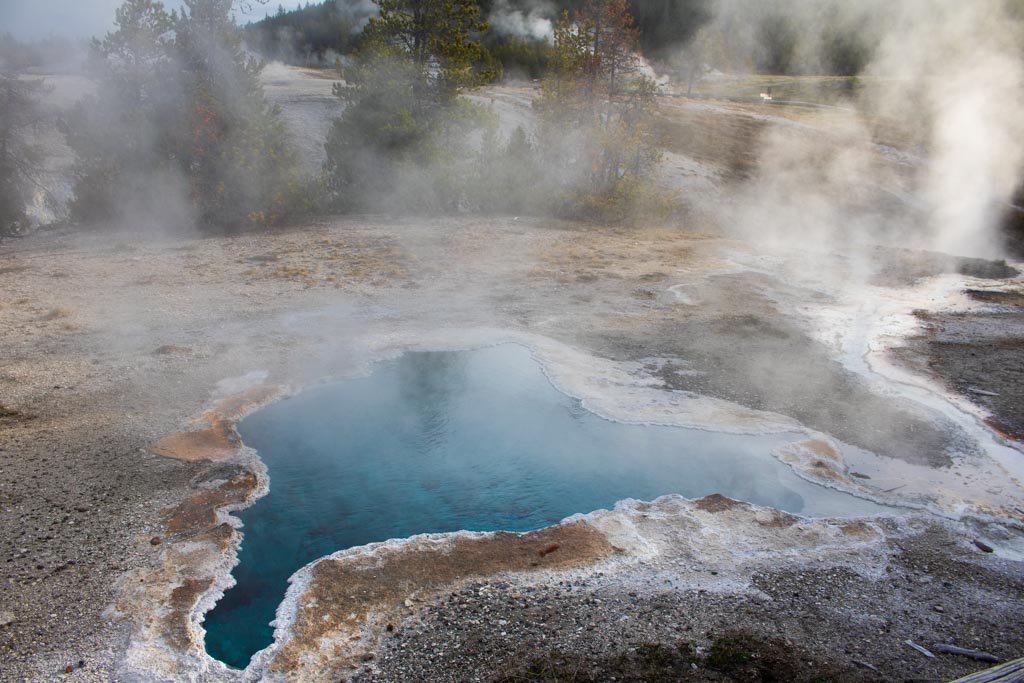
Named for its slight resemblance to a star, Blue Star Spring has arms that extend from the middle of the pool. One of those arms is an overflow channel.
The water of Blue Star Spring, also as its name suggests, is vibrant blue thanks to the high temperature. In fact, Blue Star is so hot that very few thermophiles are able to survive there—there are almost no colorful rings around this hot spring.
11. Opal Pool
- Location: Midway Geyser Basin
- Temperature: 132°F (56°C)
- Acidity (pH): unknown
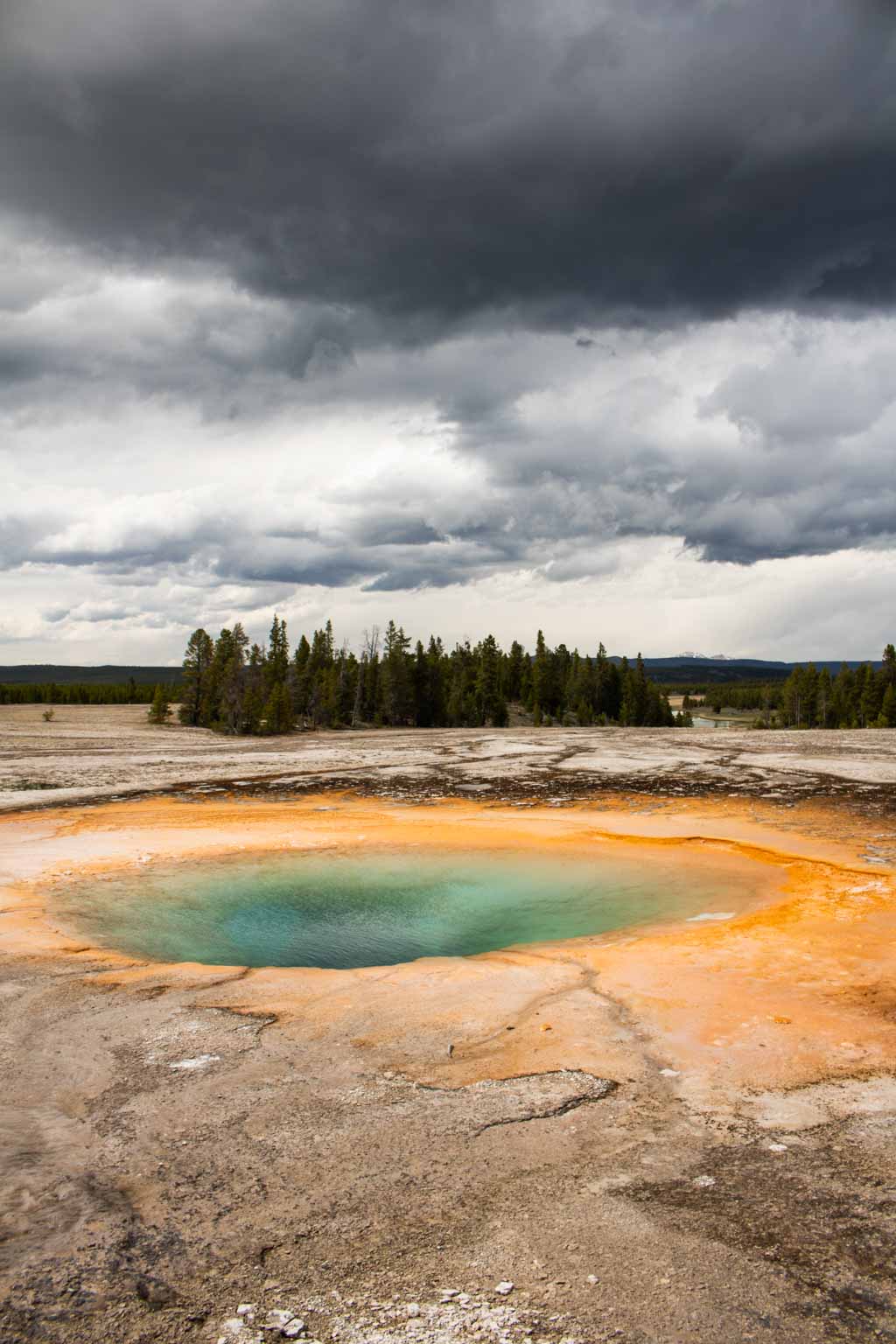
Located in the Midway Geyser Basin, which is known primarily for Grand Prismatic Spring (see below), Opal Pool is a beautifully colored thermal pool. Its water has a stunning blue-green hue, while it’s fringed by yellow and orange thermophiles.
Opal Pool is particularly fascinating because, although it usually acts as a hot spring, it’s also known to erupt—like a geyser.
The first recorded eruption of Opal Pool was in 1947, recurring a few more times in subsequent years. Since 1979, there has been at least one eruption of Opal Pool every year. Even though it is capable of erupting, it’s still considered a hot spring, not a geyser.
Top 10 Hot Springs in Yellowstone National Park
10. Emerald Spring
- Location: Norris Geyser Basin (Back Basin)
- Temperature: 181.9°F (83.3°C)
- Acidity (pH): between 3 and 4
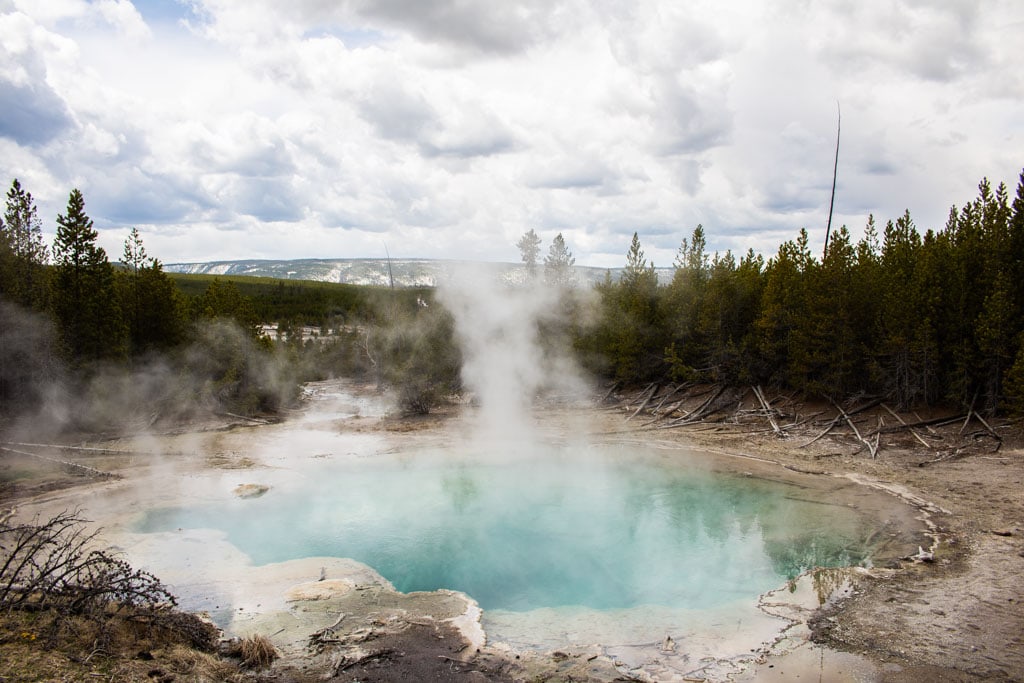
Emerald Spring is one of the most striking hot springs in the Norris Geyser Basin, one of the hottest and most acidic of the hydrothermal areas in Yellowstone National Park.
It was named after its clear blue water and the slight yellow color of its sulfur coating. The smell of sulfur is undeniable here.
The water is so blue because it’s extremely hot—close to boiling—and only the most heat-resistant thermophiles can live there. Those particular thermophiles, the ones that live in the hottest water, either have a yellow color or are colorless.
Additionally, Emerald Spring is one of the largest acidic geysers in the park.
9. Black Pool
- Location: West Thumb Geyser Basin
- Temperature: 163.2°F (72.9°C)
- Acidity (pH): about 8
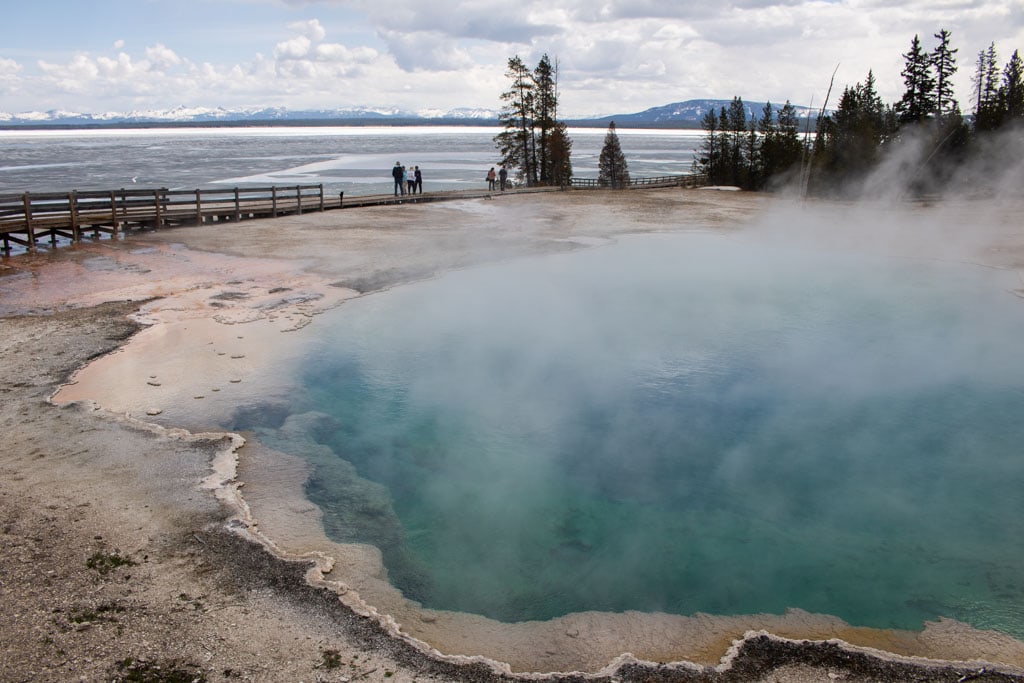
A major feature in the wonderful West Thumb Geyser Basin on the shore of Yellowstone Lake is Black Pool. The view of the steaming hot spring with the cold lake in the background is magnificent.
When the hot spring was named, it was much cooler than it is today and home to green and dark-brown thermophiles. It was quite a dark pool, in other words.
However, a shift in thermal energy in 1991 caused the water to significantly heat up, killing those particular thermophiles and replacing them with more heat-resistant ones.
Now, the water of Black Pool is a deep blue color with yellow-colored thermophiles living along its edges.
8. Silex Spring
- Location: Lower Geyser Basin (Fountain Paint Pot Area)
- Temperature: 174.7°F (79.4°C)
- Acidity (pH): 8.4
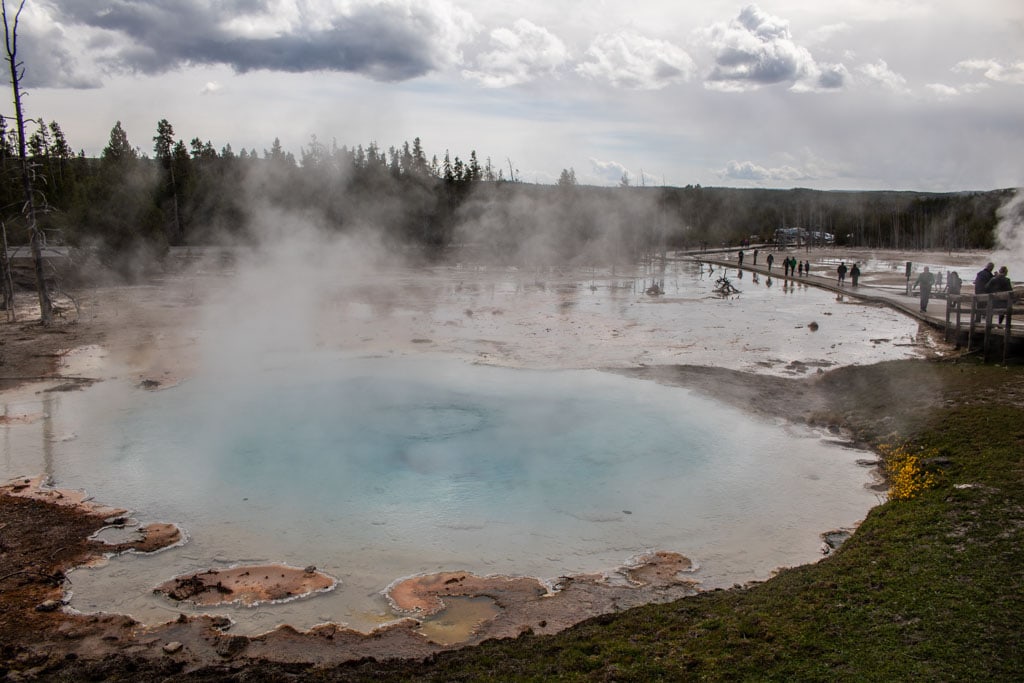
The wonderful Fountain Paint Pot Area, part of the Lower Geyser Basin, is home to four types of hydrothermal features: hot springs, geysers, mudpots, and fumaroles.
One of its star attractions is Silex Spring, a stunningly blue pool named after its large amounts of silica—silex is the Latin word for silica.
“Silica comes from the underlying volcanic rocks, which the hot waters dissolve. This silica is then deposited as sinter, which lines the pools and forms terraces along the runoff channels,” the National Park Service explains.
The expansive runoff channels from Silex Spring parallel the boardwalk from the parking lot. A variety of colors can be seen here, indicating the presence of many different thermophiles.
7. Sour Lake
- Location: Mud Volcano
- Temperature: unknown
- Acidity (pH): about 2.5
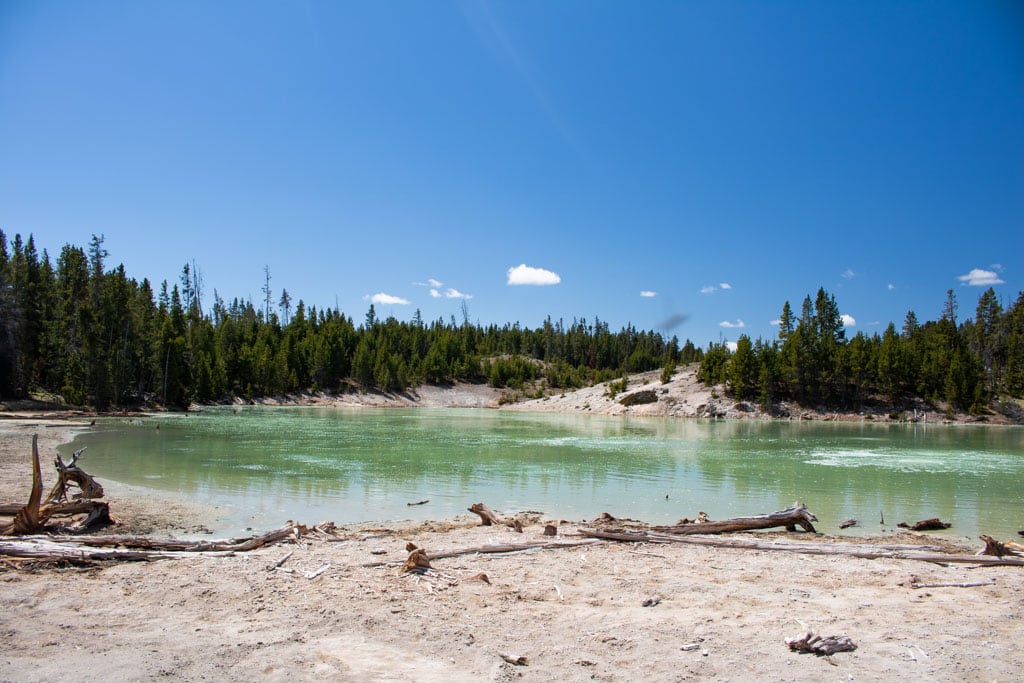
Fed by a spring, Sour Lake is not technically a hot spring itself, but it’s absolutely worth including here because it’s so extraordinary.
Situated in the Mud Volcano Area, which is most famous for its mudpots and fumaroles, this lake is extremely acidic. Its pH of about 2.5 puts it in between cola and lemon juice in terms of acidity.
Its acidity comes from the sulfur that is abundant here, which is converted into sulfuric acid by thermophiles.
It’s vibrant—almost fluorescent, chemical-looking—green color makes it actually look acidic.
For reference, there are even more acidic pools at Mud Volcano, especially the ridiculously acidic Sulphur Caldron, which has a pH of 1-2 (similar to stomach acid.)
6. Black Opal Pool
- Location: Upper Geyser Basin (Biscuit Basin)
- Temperature: 98.2°F (36.8°C)
- Acidity (pH): 8.7
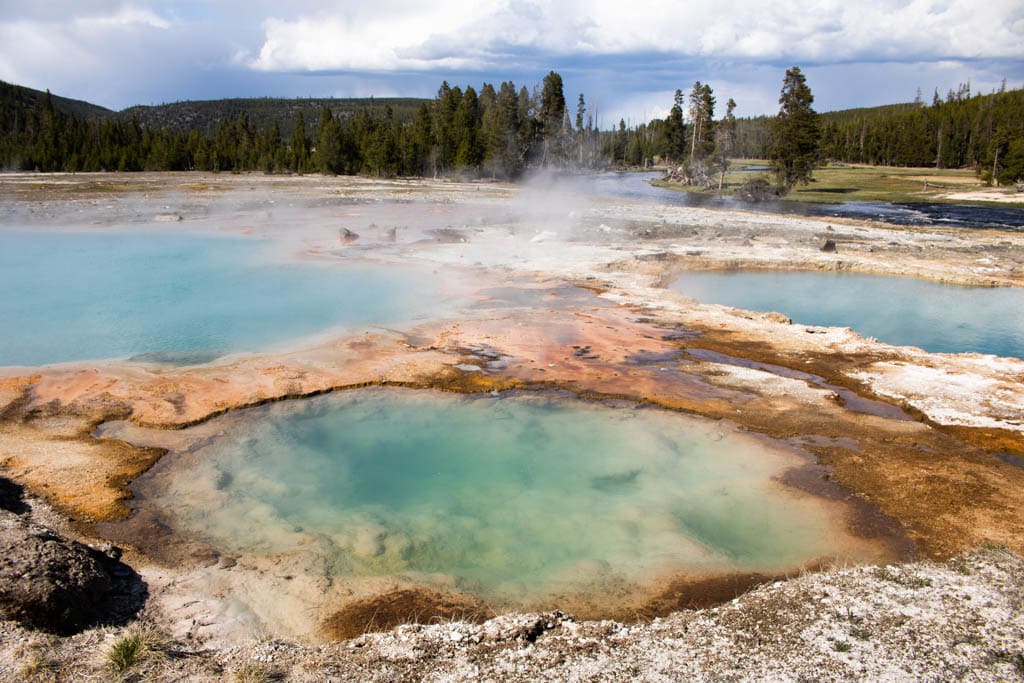
Not to be confused with Opal Pool or Black Pool, Black Opal Pool is situated in Biscuit Basin, a small basin near the Upper Geyser Basin. It was created in 1934 after a series of steam explosions.
Because of its bright colors and surroundings, I think it’s one of the most beautiful hot springs in Yellowstone National Park. Its murky blue water flows into other adjacent hot springs and eventually into the nearby Firehole River.
Additionally, this is one of the “cooler” hot springs in Yellowstone. Dark thermophiles line the edge of the pool, while its runoff channels are home to green and orange thermophiles.
Top 5 Hot Springs in Yellowstone National Park
5. Crested Pool
- Location: Upper Geyser Basin
- Temperature: 191.1°F (88.4°C)
- Acidity (pH): 8.9
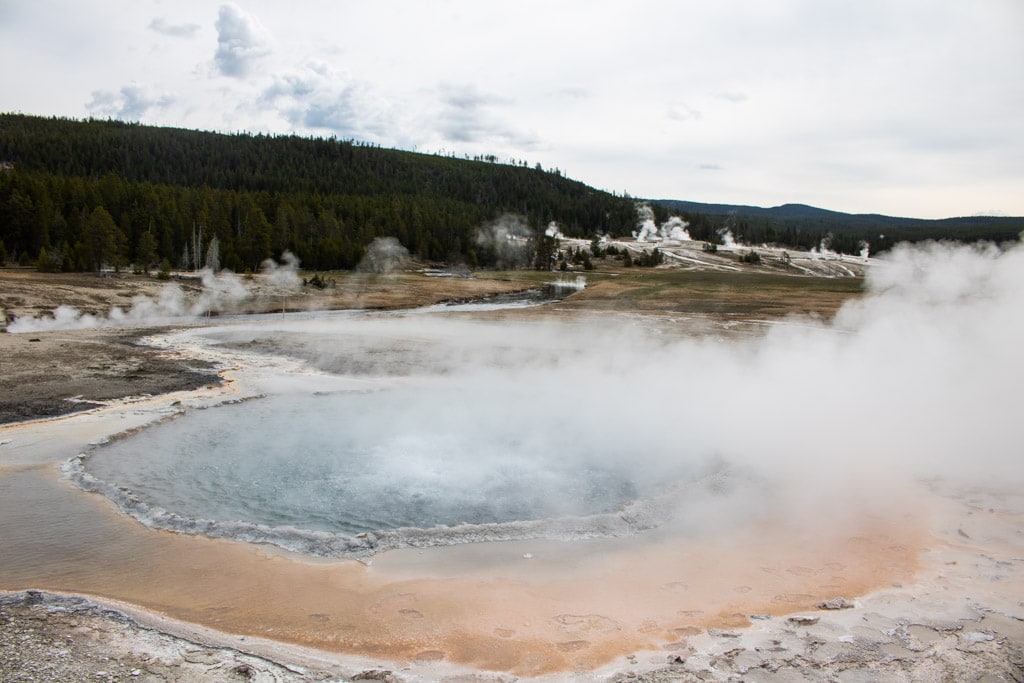
Crested Pool is remarkable in the sense that it’s perpetually at or near boiling point. This causes it to occasionally explode and shoot water into the air—much like a geyser does.
It’s not a geyser, though, because it does not have constrictions in its underground plumbing system that block its water flow.
That said, the simple fact that this is a potentially explosive hot spring justifies its number 5 position in this list of must-see hot springs in Yellowstone National Park. It’s an extraordinary hot spring. You’ll find it right next to Castle Geyser in the Upper Geyser Basin.
Additionally, Crested Pool is extremely clear and blue. Because its water is so hot, most bacteria can’t live in it—only the hardiest of thermophiles survive.
Although there are virtually no thermophiles in the water, they do live just outside the pool where they’re noticeable as thick orange-colored mats.
4. Sapphire Pool
- Location: Upper Geyser Basin (Biscuit Basin)
- Temperature: 159.8°F (71°C)
- Acidity (pH): 7.9
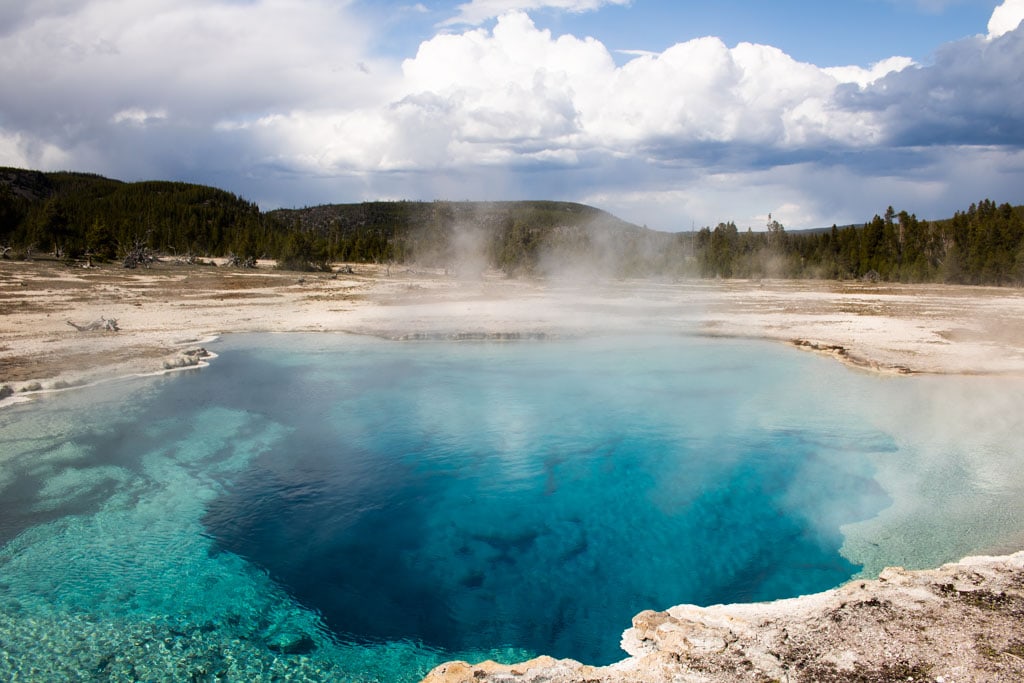
One of the most majestic hot springs in Yellowstone National Park is Sapphire Pool. You’ll find this one in Biscuit Basin, which gets its name from “the biscuit-shaped geyserite formations” that are visible around Sapphire Pool.
The deep blue water is fringed by a sinter rim, while the shallow sinter shelves around the pool are home to yellow and orange thermophiles. This is an absolutely stunning Yellowstone hot spring, both in terms of size and clarity.
Before the earthquake of 1959, Sapphire Pool was a so-called “active geysering pool.” It had muddy water and active eruptions for more than a decade after the earthquake. Its eruption activity slowed down in 1971 and the water became clearer.
The last eruption of Sapphire Pool was in 1991, which indicates that the earthquake has permanently shifted the hot spring’s underground plumbing system.
3. Morning Glory Pool
- Location: Upper Geyser Basin
- Temperature: 159.3°F (70.7°C)
- Acidity (pH): 7.6
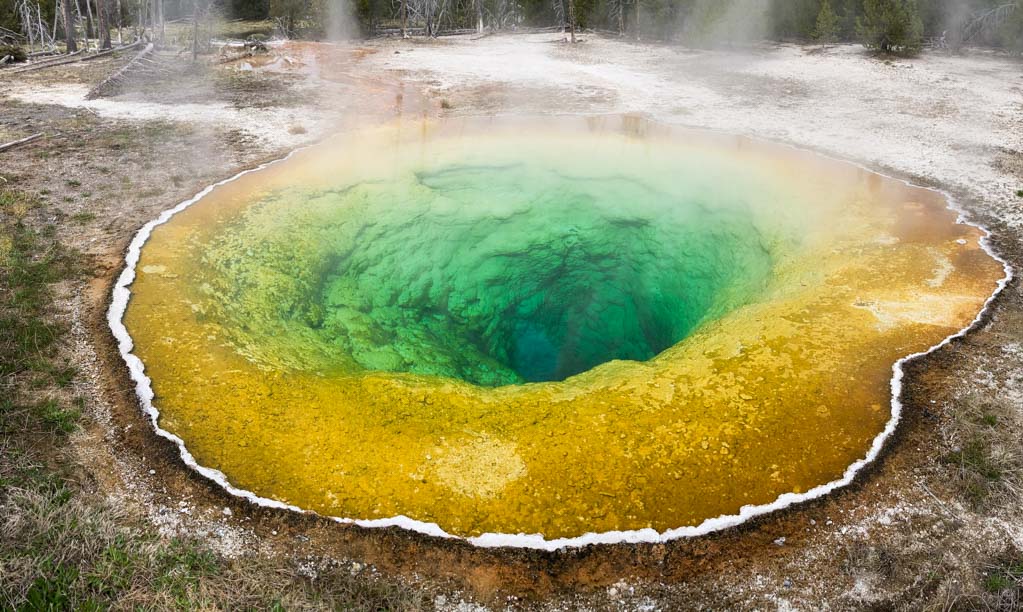
A major attraction near Old Faithful, Morning Glory Pool is easily among the most spectacular hot springs in Yellowstone National Park, if not the world.
It’s a gorgeous pool that displays a wide variety of colors, from blue and green to yellow and orange.
Ever since the earliest days of the national park, this particular pool has been a massively popular destination. It got its official name in the 1880s after its resemblance to its namesake flower.
Morning Glory Pool, reachable via a 2-mile roundtrip hike from Old Faithful, has had its issues, though. The main one is vandalism—visitors have thrown literally thousands of pounds of trash, coins, sticks, and rocks into the pool.
This debris got stuck in the sides and vents of the hot spring, reducing its water circulation and, as such, its temperature. It is worth noting, however, that the cooling of Morning Glory Pool may also have natural causes.
2. Mammoth Hot Springs
- Location: Mammoth Hot Springs
- Temperature: 160°F (70°F)
- Acidity (pH): around 6.5
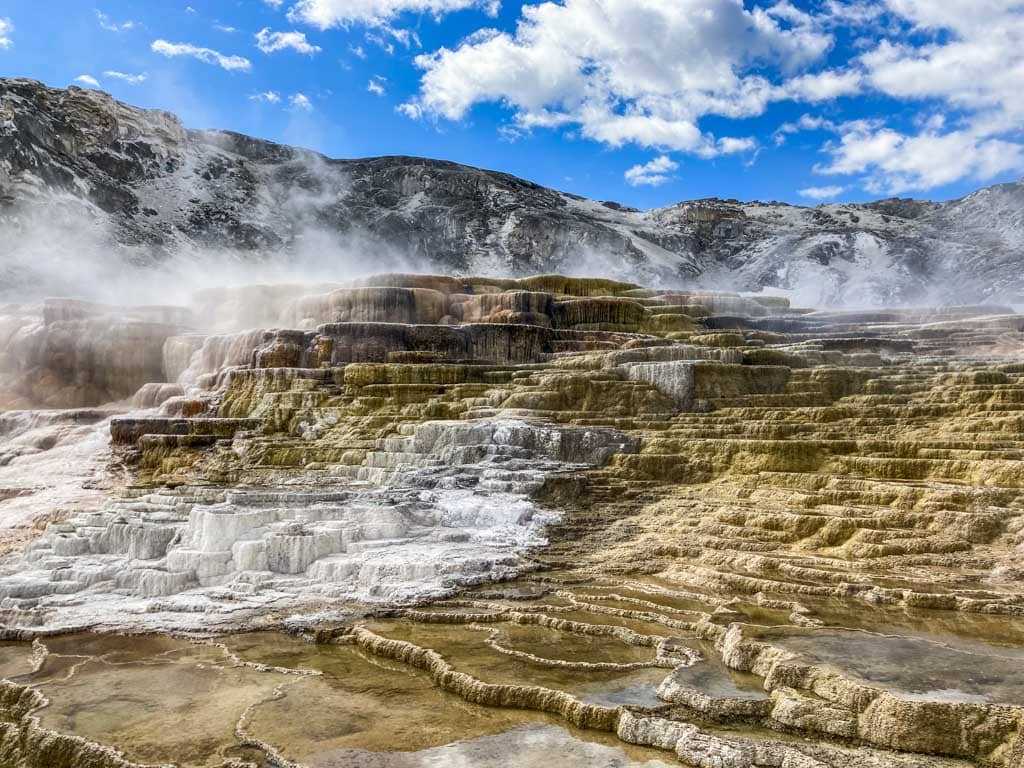
One of the absolute top things to do in Yellowstone is a walk on the Mammoth Hot Springs boardwalks.
One of the park’s many, and among its most extraordinary, hydrothermal areas, Mammoth Hot Springs is a stunning collection of travertine terraces, the result of limestone deposited by hot springs.
In fact, travertine builds up so quickly here, while hot springs dry up and come back to life sometimes overnight, that this is among Yellowstone’s fastest-changing areas. Mammoth Hot Springs literally looks different each year.
A network of boardwalks and stairways runs through the Lower Terraces, allowing you to see marvelous geothermal features like Palette Spring, Minerva Terrace, and Cleopatra Terrace from up close.
Liberty Cap, at the base of the Lower Terraces, is a solidified 37-foot former hot spring cone. At the top of the Lower Terraces, Canary Spring is a gorgeous white-and-orange hot spring, arguably the most beautiful feature in this particular area.
The Upper Terraces can be explored on the 1-mile Upper Terrace Drive, a one-way drive that’s usually open between mid-May and November.
1. Grand Prismatic Spring
- Location: Midway Geyser Basin
- Temperature: between 145.4 and 188.6°F (63 and 87°C)
- Acidity (pH): about 8.6
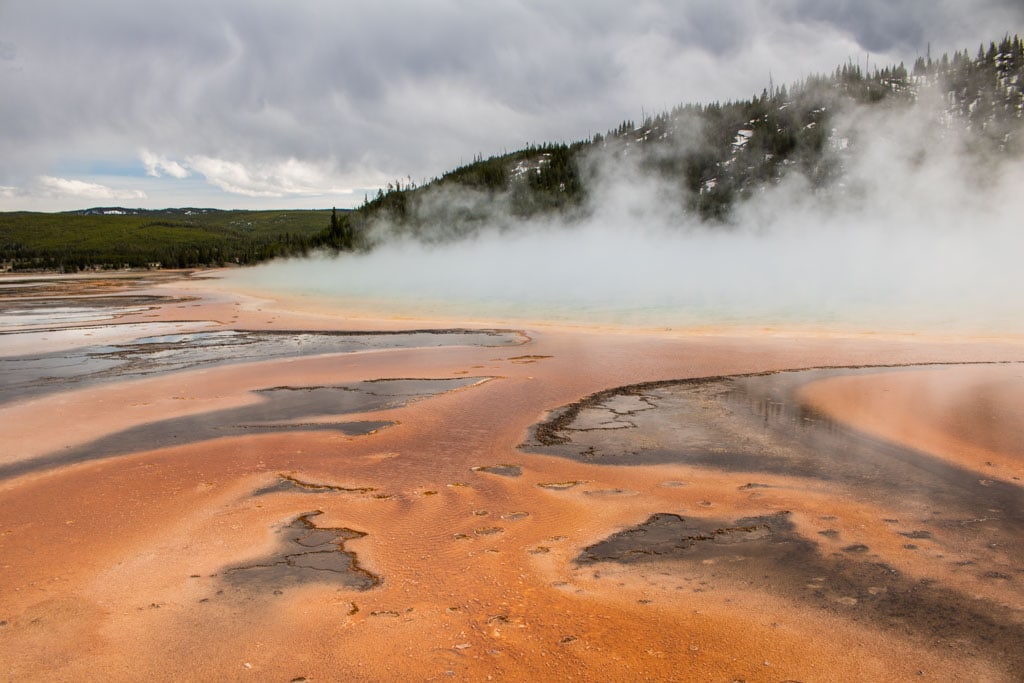
Measuring 200-330 feet in diameter and over 121 feet deep, Grand Prismatic Spring is the largest hot spring in Yellowstone National Park and the United States. (It’s the third-largest on Earth.)
This breathtaking hot spring is in the Midway Geyser Basin and accessible via a short boardwalk loop. From the boardwalk, you can admire the sensational variety and vibrance of its colors, from deep blue and bright green to yellow, orange, and red.
You can clearly see how the change in temperature—the water cools as it runs away from the deep, hot pool itself—results in colonies of different thermophiles.
Another way to see Grand Prismatic Spring in all its glory is from the Grand Prismatic Spring Overlook Trail. After a 0.6-mile hike from the Fairy Falls Trailhead, this viewpoints provides a panoramic view of the hot spring below.
Map of Must-See Hot Springs in Yellowstone National Park
This map shows the general location of the Yellowstone National Park hot springs described above. For more detailed locations, I recommend zooming in on this map on park’s website.
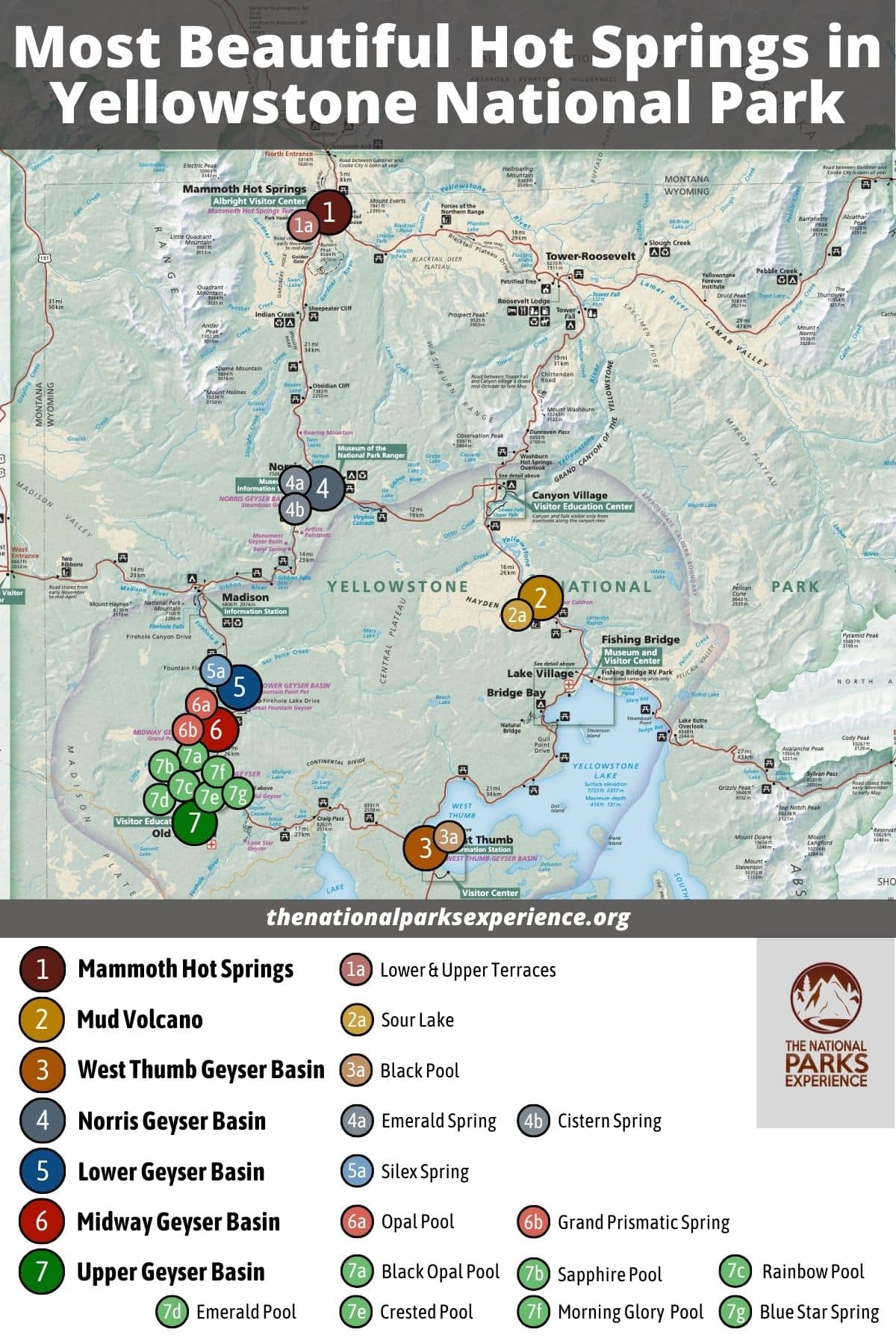
More About Yellowstone National Park
- Park Website
- Travel Guide
- Topographic Map
- Top Places to Visit in Yellowstone National Park
- Best Spring Hikes in Yellowstone
- Where to See Wildlife in Yellowstone National Park
- Beautiful Roadside Waterfalls in Yellowstone
- Best Scenic Views in Yellowstone National Park
- Accommodation
